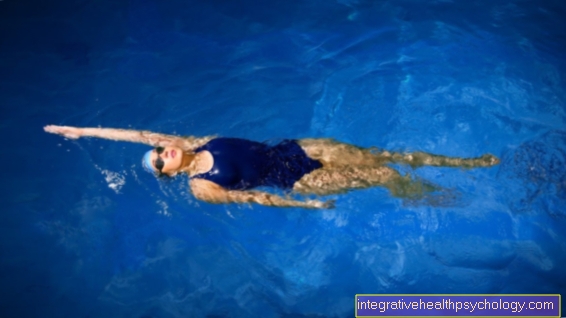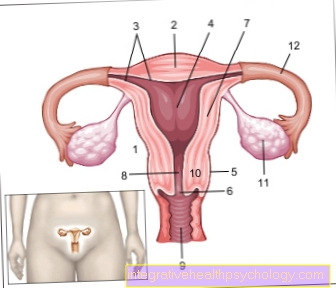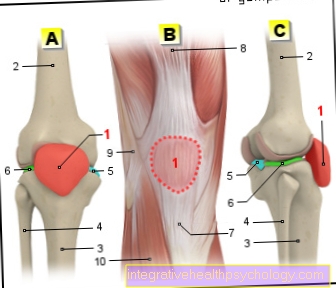tennis
introduction
Tennis as a 2-field return sport with a one-contact game. In tennis, the ball may only bounce once and can therefore be played directly as a volley or indirectly via the net. The opposing field as a target area is large in relation to other return sports.
In tennis, a winner is determined in any case, the playing time is variable. With the exception of the serve, every stroke in tennis is a reaction to the action of the opponent.
history
The origins of today's tennis game emerged in the 13th century in monasteries and royal houses. At first the ball was played out of hand and it was not until the end of the 15th century that the tennis racket came into play. The playing field was rectangular and separated on each side by four 15 inch wide lines. Along the playing field ran a wall against which the ball had to be hit. The game was named "Jeu de Paume"(Playing with the palm)
Tennis with today's counting method, the rules we know and the new playing field originated in Wimbledon (London) in 1877.
In 1933, professional tennis was first introduced, which only allowed professional players access to tournaments. However, that changed when the open tournaments were introduced in 1968. The name tennis originated from the French Word "tenir" (to hold).
requirements

Although the clubs have seen a decline in membership in recent years, tennis is one of the most popular sports in Germany. The particular level of physical and coordinative skills makes tennis attractive for both beginners and advanced players. In hardly any other sport is the connection between force and technology as demanding as in tennis. A solid base endurance every player should bring along in order to be able to assert himself after several rounds and no losses in the coordinative area can be recorded. In addition to strength and endurance, the speed, especially the ability to sprint over short distances is probably the most important conditioning ability in tennis. A targeted one Muscle building of the Abdominal muscles and Back muscles is therefore particularly recommended for beginners as well as advanced. If there are problems with the musculoskeletal system, an examination by a doctor is advisable.
Other conditions for tennis are the materials that are essential for playing tennis. The equipment and court rental are therefore a financial requirement. The times of high admission fees from tennis clubs are over, and tennis is now a sport for everyone.
Goal of the game
The aim of tennis is to play the ball over the net into the opponent's field in such a way that the opponent can no longer reach the ball or is forced to make a mistake. The tennis ball must be properly played into the generic field after it has hit no more than once. The boundary lines are part of the playing field, so a ball that just touches the line is still in play. The ball is played with a so-called service into the opposing service area. Each player has two attempts to do this. If the second serve fails to meet the service field in accordance with the rules (Double fault), counts this as a mistake and the opponent gets one point. If the ball touches the edge of the net when it is served and then correctly enters the service area, this service is repeated. The winner is the player who first won the required number of sets.
Counting method
The somewhat unconventional way of counting points in tennis is based on two independent theories. The likely origin is based on betting stakes in the 14th century. Back then you bet 15 denir per set, which in turn consisted of 4 games. 45 was changed to 40 for convenience of pronunciation.
The second theory relates to the original four lines running parallel to the mesh. After each point won, the player was allowed to move one line forward. The lines were spaced 15 and 10 inches apart.
An entire tennis game is called a match denotes that in turn Sentences and Play consists. (In tennis, this is often misleading for the ignorant, since a won game is not to be equated with a victory).
Whoever has won two sets first is the winner.
A sentence is won if a player:
- Has won 6 games and the opponent has won a maximum of 4 games. (6: 0, 6: 1, 6: 2, 6: 3, 6: 4)
- If the score is 5: 5, the game is extended to 7. (7: 5)
- At 6: 6 the tie break decides. (7: 6)
A game:
In a game, the counting is 0, 15, 30, 40. A game is won when a player can win the next point after reaching 40 points.
If the score is 40:40 (debut, deuce), you must win two points behind. If the server scores a point on debut, the exclamation is "Advantage on", When scoring a point by the receiver it says"Advantage back“
The server named first in the counting method begins with the surcharge from the right (0-0). When the point is won (15: 0), he hits from the left ...
Tie break:
A won tie break is counted as only one game won (from 6: 6 to 7: 6 or 6: 7), but it is decisive for the set when the score is 6: 6. It starts with 0: 0 and each point won does not count as in game 15, but only 1. Whoever reaches 7 points with at least 2 points difference has won the set. Possible results (7: 0,… 7: 5. 8: 6, 9: 7 ..).
Since the serving player has an advantage in tennis, player 1 only serves one rally, then alternately twice. At the beginning of the tie break, the player who had a return in the previous game has the right to serve. After 6 points have been played (e.g. 5: 1, 4: 2 ..) a change of sides takes place without a break.
With every unequal score in the set, the side is changed with a pause. With (1: 0) in every set there is a change without a break. A player has cue ball if he can win the game with the next point. A set ball is given to the player who wins the set with the next point, and if the player can win the entire match with the subsequent rally, it is called a match point. If a player has the opportunity to win the game with the following rally during the service game of the opponent, this is called breakball. If he succeeds it is a break.
Basic strokes
The basic strokes in tennis include:
- forehand
- Backhand
- surcharge
- volley
- smash
The playing field
The tennis court is divided into two equal-sized rectangles by a net. The length of the tennis court is 78 feet (23.77m) from baseline to other. The width for the double field is 36 feet (10.97 m) and for the single field is 27 feet (8.23 m). The service lines (commonly known as tea lines) run parallel to the net on both sides at a distance of 21 feet (6.40 m). The service center line runs at right angles to the service line up to the net. It divides the T-field into two equal rectangles, the service fields.
The net is 3 feet (0.914 m) high in the center and 3.5 feet (1.07 m) in height at the posts.
The area between the baseline and the fence is 18-21 feet (5.50m- 6.40m) long.
Tennis.
Tennis is played on different surfaces.
The most common are: sand (french open), grass (Wimbledon), hard court (us open), rebound ace (australia open).
furthermore, granules, carpet, artificial turf.
Tennis court

- Baseline
- Single outline
- Double outer line
- network
- Service center line
- Service line
- Middle sign
Risks
Tennis is a sport with quick changes of direction, so the stress on the joints is particularly important Ankle, Knee joint, Shoulder joint and hip joint especially high. Proper footwear is recommended on non-slip surfaces such as carpets, hard rubber, etc.
A targeted one Muscle building of the Back muscles counteracts the one-sided stress of playing tennis. In addition, there is a risk of a tennis elbow when playing tennis (Tennis elbow).
You can find more information about tennis elbow under our topic:
- Tennis elbow
Game strategies
Serv & Volley:
Serv and volley is part of the game strategy on fast surfaces (grass, carpet). Here the serving player tries to get to the net immediately after the serve in order to win points early by playing hard. Difficulties in serving and volleyball are overcoming the field of play, where the attacking player often has to play a half-flight ball (drop-kick) or deep volley at the level of the service line. Typical Serv and Volley players were Boris Becker, Pete Sampras, John McEnroe and others.
Chip & Charge
The return player tries to get on the net immediately after the return game. This is then done by a “chipped” hit (chopped / slice) and then moving up (charge).
This form is mostly used on second serves and counts more as a surprise element.
Baseline game
The most common form of strategy in tennis is playing from the baseline. Here the attempt is made to place the ball in such a way that the opposing player can no longer reach the ball or is forced to make a mistake by playing hard from the baseline.
Tennis and coordination
Here you will find detailed information on the subject of coordination with regard to tennis. The individual coordinative skills are described in detail using tennis. coordinative skills.
Further information
Further information on tennis can be found here:
- surcharge
- forehand
- Backhand
- One handed backhand
- Volley forehand
- Volley backhand
- smash





























